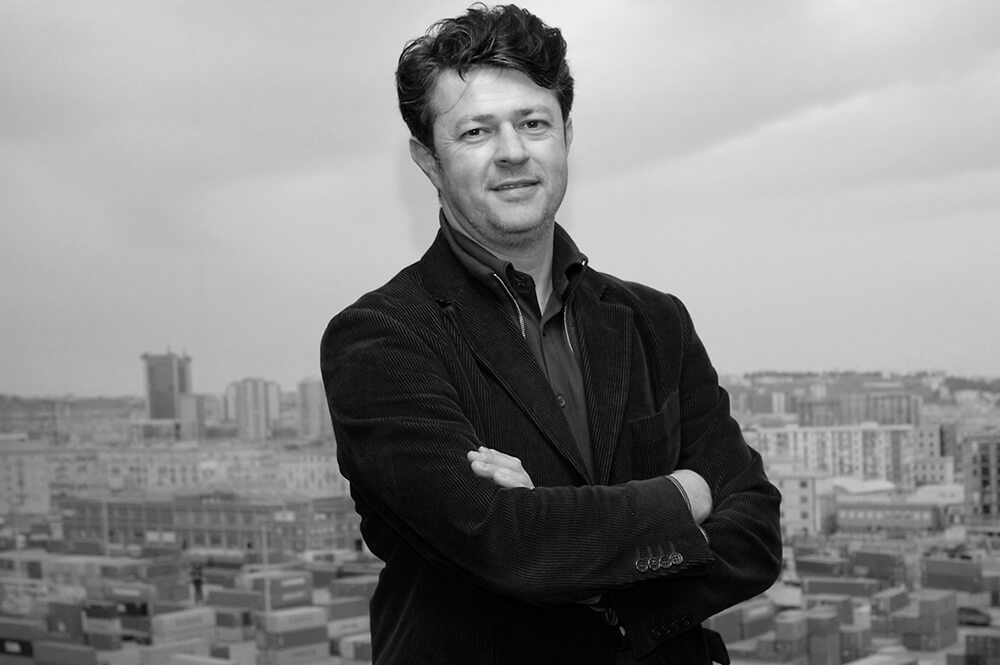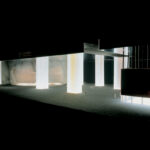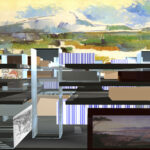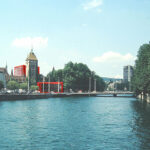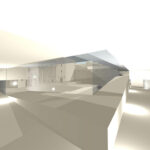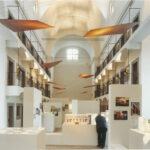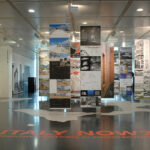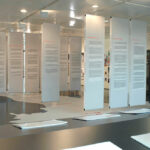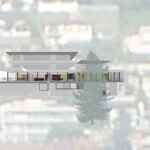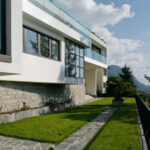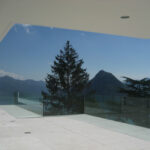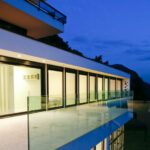ArchiTravel interviews the Italian architect Alberto Alessi, on architecture and travel.*
Interview by : Maria Anagnostou (video shooting and editing) and Sofia Tzereme
Sofia Tzereme: What is the importance of architectural tourism?
Alberto Alessi: It is very important to visit architecture. I wouldn’t use the word tourism, because tourism has something to do maybe with a kind of exploiting, using things in a kind of happy, but not so definitive way. I would say about making the architecture experience. That means to go to places, to have a look at the places, to experience. It’s really a question of experiencing. When you speak about tourism, it has a lot to do with the industry of entertainment. I think architecture is much more than just entertainment. Of course, it has also this level of being present. It’s very important to go to places. Architecture is something that you can discuss, but you have to experience.
S.F.: What is the importance of traveling, especially for architects and humans in general?
A.B.: It’s absolutely necessary. If you travel, you can see, feel and, as I said, experience what other people and societies are thinking about the way of life, the way of living, the way of staying on the earth. It’s just traveling in this way, traveling and trying to exchange with others that you get to a point where you can accept. People coming here and you are going there, so you can see things from another point of view, from the opposite point of view. Sometimes, when you travel, you are the “white mosquito” in the system. This is fine.
S.F.: What do you think is the added value that architecture creates within a city?
A.B.: There is no city without architecture and there is no architecture without cities. Also, the buildings alone in the landscape, at the end they are searching for a city. They are searching for exchange. For me, city means to live together, to share experiences, to share a way of life, to share ideas and to deal with this sharing. Architecture is the space for this. One architecture and another architecture and another architecture make a city. But, the city is not only the buildings. The city is also the life that is inside. The one is before the other and so is the opposite. There is a city that asks for architecture and there is an architecture that makes a city. There is a society that deals with all of these.
S.F.: What is the importance of architectural events worldwide? What are the profits for a city holding this kind of events?
A.B.: There is an ambiguity. On the one hand, it is very important because you have the possibility to see, live, hear and discuss about questions, not only your questions. It’s not only the questions of a small society, you have people coming from outside, dealing with themes that maybe have also to do with your point of view, maybe not, but they open some horizons. On the other hand, it’s dangerous because it could become a kind of traveling group of stars and starlets going around, making a kind of history on its own that doesn’t deal with the real problems. This is a little bit dangerous for me.
S.F.: You run your own atelier in Rome and Zurich, working as an architect, teacher, critic and curator. As an architect, you work on projects at different scales: exhibit design, residence, city projects.
European cities have a great history. Designing a modern building within this context is a complex procedure. Is critical regionalism an approach to your architecture?
A.B.: If you look at the critical regionalism as a kind of method, I don’t think so. What is important is always to be open to the situations and to be also open to the history of the situations. That means, if you have to build in a context, for example if I build something here, in Thessaloniki, you have these Byzantine churches but you have also the new city. How do you decide what is more important and what is less important? It’s only because something is older, so it has much more importance than something new or it’s something new that is better than something old. It’s always a question of understanding where you are, in which situation you are, what the needs of the moment are, what the needs of the permanence of the culture are. It’s not always something old that is better than something new. It’s not always something new that is better than something old. To me, it’s every time other stuff. The only commitment is that you are taking into account everything. Then you have to decide, and you do it on your own, but also in exchanging and knowing what the point in this place is really. You need to be continuously open. Don’t go there and say: “I want to put my sign to it. I want to put there my kind of statement that it’s me against the world.” It’s more a kind of listening, but you have also to react. If you just listen it’s nice, but you are asked, as an architect to add something. What you add should be as far as possible, added still open. You must be aware that everything you do creates a new context. There is a context before your intervention and there is context after your intervention. This context, after the intervention is a new one, somebody who will come later to build will take also your intervention into account. In this sense you are, at the same time, old and new.
S.F.: You are responsible for the web platform Italian-Architects.com. How would you characterize contemporary Italian architecture?
A.B.: I wouldn’t speak about Italian architecture or about Greek architecture or about Swiss architecture. I would speak about architecture in Italy or architecture in Greece or architecture in Switzerland, for instance. What I mean is that it’s important to see that we are no more in a period where everything is quite clear and there is a direction, a society as a clear task, as a clear vision. They are many visions that are contemporarily, in the same time, possible. If I have a look on what is happening in Italy, I could say that there are different situations and every situation in every city or region of Italy drives us elsewhere. If I have to find out a kind of coherence between the different architectures that are realized in Italy, there is a kind of agreement that architecture is always something that has to do with the city. I said it already before. In Italy, it’s very clear. The Italians are always thinking as citizens, even if they build outside of the country. So, the idea is to be a kind of city man, also outside. This is something that lies very deep inside in the Italians. I did also some exhibitions about Italian architects. One was in the States and the title was “Italy now”, for instance. It was a question point. What does it mean? To build now in Italy does it take some Italian architecture that exists? And the answer was quite known for all architects. There is no Italian architecture, but there are possibilities. Sometimes, you are similar to somebody else because you cannot do something. You would like to build in wood, but there is no knowledge so nobody is building in wood, for instance here. But it’s not because you don’t want to, it’s just because you cannot. So, it’s a similarity because of the impossibility. Sometimes, it’s a problem of situation. Something that comes often to Italian architects, speaking about architecture, is that they use often the word beauty. That beauty we know now is not so easy to define, but they use beauty, not only interesting. Something you can say is that it is a kind of ground statement, basic statement.
S.F.: Is the world financial crisis an opportunity for everyone to reconsider the ways that we design and construct the buildings and the urban environment?
A.B.: Yes. Every crisis, every difficulty is a possibility to go further, because you have to think twice everything you do. It’s not just to copy-paste or to make a reaction that there is already. You have to find, you have to search. And searching means go deeper in the sense. Go deeper to form your questions. Now, about the crisis, could be questions that come about on sustainability. But sustainability is not only a question of using too much of few materials or using some good or wrong materials. Sustainability is also what can be afforded by a society. Is there some kind of form acceptable by a society? Can they sustain this also philosophically or not? It’s much more complex. In this crisis, in this moment, this possibility exactly comes out. Think different. But, think different because you need to think different, not because it’s trendy.
S.F.: You have written several books on architecture. Can an architectural book influence ordinary people, non architects, to deal with architecture and demand better urban environment? How can this be done?
A.B.: It depends. When you do a book and you want also a non architect to be interested in the book, in the themes and the texts that are in the book, then you have to project this. So, you have to deal with the question.
I did some holography about some architects where I tried to figure out general themes that are not only important for architects. Maybe somebody can find it quite interesting, even if he’s not an architect. Some other books were dealing more with themes and there it’s easier because themes are not only a question about architecture. We have general themes that are important for us as a society, architecture belongs to the society. This is a way that you can write or work out books that can also interest other people. You have to project this. You have to find out a way that a book is really readable from different points of view. Sometimes there are books that are not for architects, but they are very important for architects. I talked before about the “Invisible Cities” by Italo Calvino that for me is really an important book in this sense, because it opens visions. You can get this when you work out the possibility of having visions. That makes you take a desire to do this, to do something that can become architecture for non architects, also.
S.F.: At the end, can you please provide your personal proposal for 10 buildings which you think as the most important worldwide that someone must visit anyway?
A.B.: To me it would be easier to say maybe ten cities. What is important is to try and be always aware that when you do a building you are not doing a kind of design object that you can place everywhere. It has always to do with a context, with a reality. It is there, in this city, in this corner of the city, behind this building, in this moment. This is important because if you don’t work this way, you go back to the idea of the event that you do this, tomorrow nobody cares about this. In this sense, as example I would say a city like Split that is in Croatia. It is a city that was a palace, a palace for the Croatians so in the Roman period it was a building and now it’s a city. It’s the city within the building and the building as a city. This is a very strong example. Then, I would say New York for the way the city is also a structure and the city of architecture in the same time. I would say Beijing, because it’s another concept. I would say to go outside, around the corner and find out all of these. Of course there are hierarchies and there are monuments and things that are much more important than others. But it’s important for us, as architects to find out everywhere a kind of suggestion, a kind of beauty, and a kind of possibility. The text church, the next street but also the next corner could be a possibility.
As a possibility one could be the “Villa Hadrian”, near Rome, that is a villa for the Emperor Hadrian. It is a kind of collection of buildings that he saw around during the Empire at that time and he tried to build a kind of library of buildings, one to one, not a copy but inspirations.
Making a jump now it could be interesting and good to understand what is happening now in architecture. I’m thinking now about buildings really quite as objects. To go to the “Vitra Campus”, northern to Basel, to Weil Am Rhein in Germany where you have buildings of Herzog & de Meuron, Tadao Ando, Frank Gehry, Zaha Hadid, Alvaro Siza. Not because I think it’s important that a building has a signature. It’s the opposite of it. But, there you can understand what is happening now in architecture. You can see a kind of museum of living, open museum for living architecture.
Then, the “Lincoln’s Inn” in London, the museum of John Soane which is very incredible and it’s incredible because there you have a conversation of histories, ideas and spaces in a very small building.
Go to “Karnak” in Egypt. It is an amazing space, an amazing building that is dealing with layering horizontal.
Go to Rome to “San Clemente’ that is a church on a church on a church. It is an old Roman Villa, they built a church on it in the middle age and they built a church on that, in the mannerism period in the 16th century. So, you have a kind of vertical layering. That is incredible to understand how architecture and city deals and you see that there are elements growing, becoming another thing. They used these as foundations for the new building, but just some things. So, in the end, the new building has nothing to do with the old one but in the same time there are some points where they deal together.
Again in Rome “San Carlo” which is a church by Borromini. The quality of space is incredible. You go there and you are left astonished, without words. It’s something that is breathing together with you.
The “Thermes Vals” by Peter Zumthor is a very strong experience, as all the thermes. If you also go to Budapest, for instance, you have beauty. It feels strong because you have to enjoy this with all your body. You are there quite naked; you go in the water, hot water and cold water so you experience architecture in another way, with all your senses together.
Quite strong, quite intriguing is the building of SANAA in Lausanne the new “Learning Centre”. It’s an unexpected way to deal with the question of studying together. The space is very central there. The space is very important for architecture. At the end, you are making a kind of cells to make space possible.
I would like to finish with two of my favourite examples. The one is the “Villa Malaparte” or Casa Malaparte in Capri by Adalberto Libera. It’s not an object because it parts from the rocks on the seaside. And the other one is the “Casa Girasole” by Luigi Morreti in Rome. It is an amazing building dealing with the question of being in Rome in the ‘50s but dealing together with Rome as an eternal city. If you have the possibility, go there.
* This interview was taken on January, 2011.
More on : Alberto Alessi
About these Authors : Maria Anagnostou, Sofia Tzereme
Work of Alberto Alessi

